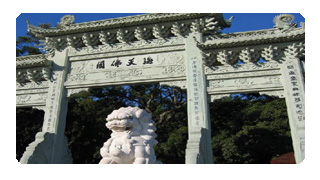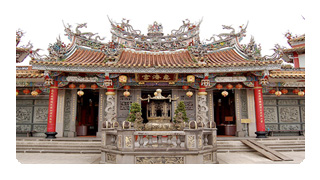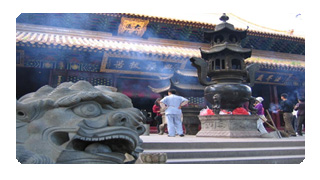The mountain of Putuo, a small island of Zhoushan
Island, lies to the east of Hangzhou Bay of Zhejiang
Province about 100 knots. The area of the whole island
is about 12.5 sq. km., and it is about 8.6 kilometers
from the north to the south, about 3.5 kilometers
from the east to the west. Besides, the highest point
of the mountain is about 283 meters above the sea
level.
Mt. Putuo covers an area of only 12.5 sq. km. while
its circumference is only 33 km. There are about 3000
to 4000 inhabitants, about 1000 of who are monks and
nuns.
In China, Mt.Putuo is one of the four big buddhist
mountains, which are Mt. Wutai, Mt. E'mei and Mt.
Jiuhua.The four Chinese Buddhist Mountains are believed
to be dominated by a major Buddha respectively, and
Mt. Putuo is regarded as the sacred mountain of Guanyin,
the Goddess of Mercy, and so the statue of Guanyin
is the only and dominant theme there.
Mt. Putuo is famous for its old religion culture and
unique island scenery. It owns many wonderful scenic
sites on the island, including temples, nunneries,
beaches, and so on. In addition, it is the famous
island scenery tourist attraction at the same time.
 Fayu
Temple
Fayu
Temple
The Fayu Temple, also named Hou Temple, is located
on the left top of the Baihua Hill. It is 2.8 kilometers
away from the Puji Temple and is one of the three
biggest temples on Mt. Putuo.
The temple was built in 1580 during the Ming Dynasty,
and it covers an area of 33,408 square meters with
294 palaces that have been preserved.
Potential take the mountain temples and the whole
temple is arranged on the six various levels.
From the gate of the hill, the layers ascend one by
one. And on the central axis there is the Hall of
Heavenly King, and then at the back is the Hall of
Jade Buddha. Between the two halls, there is the Bell
Tower, and then the Guanyin Hall, the Yubei Hall,
the Great Buddha's Hall, the depositary of Buddhist
sutra, and the Abbot Hall are behind. Besides, the
Guanyin Hall is also called the Hall of Nine Dragons,
famous for its delicate and vivid carving.
The Hall of Avalokitesvara is also called Hall of
Nine Dragons as carved exquisitely and vividly on
the walls of the hall are nine dragons.
 Huiji
Temple
Huiji
Temple
Huiji Temple, located on the top of the Foding Hill
of Mt. Putuo, is one of the three biggest temples
in Mt. Putuo. Firstly it was a Buddhist convent inside
which there is a statue of Buddha, and then it was
built as a temple in the 58th year (1793 AD) of Emperor
Qianlong's reign of the Qing Dynasty by the shaman
Nengji.
The floor area of the temple is more than 20 mu, and
the building area is 5,500 square meters. The layout
of the temple is irregular, but has the characteristic
style of gardens in South China. And the temple is
surrounded by many ancient trees and some of them
are rare valuable plants for viewing and admiring.
Besides, in the southeast there is the Baihua Peak,
and from its southern cliff you can see the four big
characters 'Buddhist Country of Sea and Heaven', which
are inscribed on the hill.
 Puji
Temple
Puji
Temple
Puji Temple, known as ''Qian Si'', is situated on
the top of the Baihua Peak, the south of the Mt. Lingjiu.
It is one of the three biggest temples on Mt. Putuo.
And it was built in the 3rd year (1080 AD) of Emperor
Yuanfeng's reign during the Song Dynasty.
The floor area of the temple is about 26,000 square
meters and it sits in the north facing the south.
Along the central axis there are the Yubei Hall, the
Hall of Heavenly King, the Hall of Yuantong, which
is the main hall of the temple and the most important
hall for the whole Mt. Putuo, the depository of Buddhist
texts, and the Hall of Abbot, and so on. Besides,
near the main hall there is the Bell Tower, the Drum
Tower, and the guest rooms, and so on. In addition,
there are also nearly 200 halls, pavilions and rooms.
There is also a pond, known as ''Fangsheng Chi'',
in the front of the temple, which is named Haiying
Pond.



